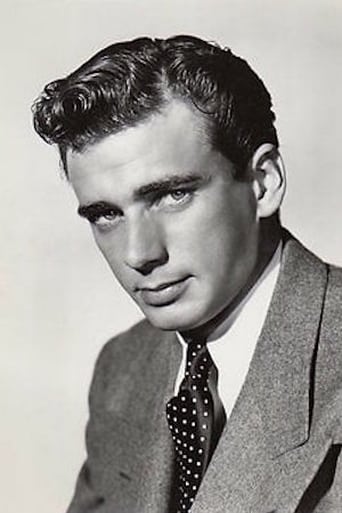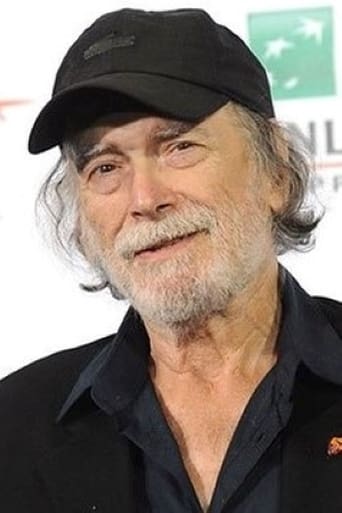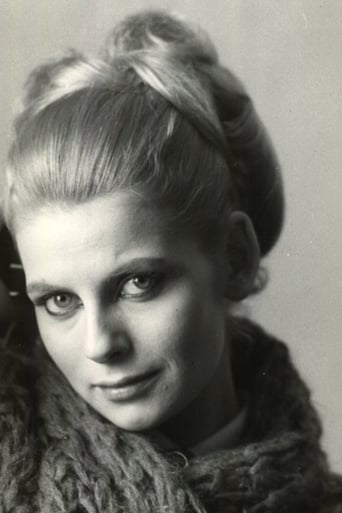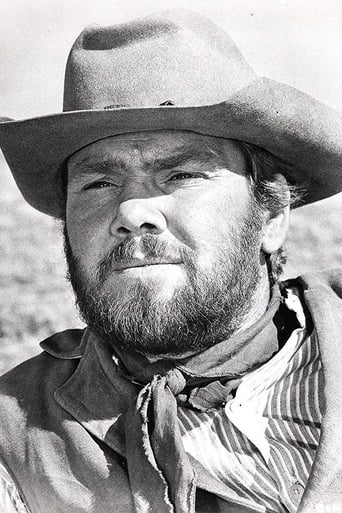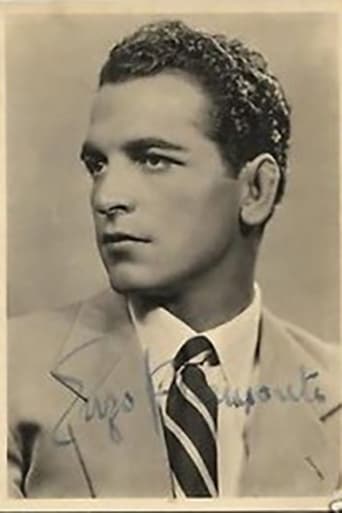RyothChatty
ridiculous rating
CommentsXp
Best movie ever!
GarnettTeenage
The film was still a fun one that will make you laugh and have you leaving the theater feeling like you just stole something valuable and got away with it.
Taraparain
Tells a fascinating and unsettling true story, and does so well, without pretending to have all the answers.
J_J_Gittes
My first film by Eugenio Martin, and I am deeply moved. Nagisa Oshima once wrote that all filmmakers want to film sex and death the most. I always understood the first part, never the second. I think, now I do. The moment when Tomas Milian's character lies on the ground, dying, his face covered with dirt, and we see only half of it, as the camera shows us an extreme close-up, with a lonely tear rolling down his cheeks as he exhales his last breaths that stir the dust of the soil to lift itself up from the ground a few more times.The relentlessness of the view. The relentlessness of the camera watching. That's been something which I've been pondering a lot ever since I started falling in love with cinema. Looking, not wanting to let go, and at last having to, at some point in time – because everything has to end. That is death. Everything is death. We die a thousand times each day.Those looks, those insisting eyes Martin keeps us showing and showing, paired with the melancholy tunes of master composer Stelvio Cipriani are the heart and soul of the whole movie. Which is a melodrama at its core, a subdued, forlorn melodrama. A film of the past, looking upon it. Once upon a time in the West.The editing is also top-notch always putting people side by side, giving everyone at least a little attention and thus creating an ensemble piece of people, connected like beads on a string. Everyone is important in this film. Because everyone is human.The dying – in the end we all have to die. I would like to think that at the end of the movie, the protagonist, a Bounty Killer, doesn't collect the bounty for Milian's character but lets the townspeople bury one of their own, one who used to belong. He is still a part of them.Anyways, the film is a statement, a demonstration, an elegy, wonderfully executed up until the end-titles which must have been some of the first in film history created in this now dominant way. 1966: After the credits have rolled, the image turns black and we remain to hear a wailing trumpet and finally the last strings of a soothing guitar. Maybe it's not what you see before you die, but what you hear. The last sounds of this world.
Witchfinder General 666
Eugenio Martin's "El Precio De Un Hombre" aka. "The Bounty Killer"/"The Ugly Ones" seems to enjoy a particular appreciation of many of my fellow Spaghetti Western fans, but, personally I do not regard the film as being above average. I have utmost respect for director Eugenio Martin for his fantastic Horror film "Horror Express" (1972, starring Christopher Lee, Peter Cushing and Telly Salavas), and leading man Tomas Milian is one of my favorite actors, but, as far as I am concerned, this one is nothing beyond enjoyably entertaining, as the story is rather unoriginal and predictable. "The Ugly Ones" is only the second Western Milian ever did, the first being Sergio Sollima's masterpiece "La Resa Dei Conti" ("The Big Gundown", 1966) which is doubtlessly one of the greatest (Spaghetti) Westerns ever to be made. Milian is doubtlessly one of the greatest actors in Italian genre/cult-cinema. Starting with Westerns (most notably Sollima's trilogy), he would later become the most charismatic villain/hero in the Poliziotteschi of the 70s (most notably in Umberto Lenzi's fantastic "Milano Odia" and "Roma A Mano Armata"), and his oeuvre also includes a variety of other great films, such as Lucio Fulci's brilliant Giallo "Non Si Sevizia Un Paperino" ("Don't Torture A Duckling", 1972). No matter whether he is the hero or the villain, Milian is always fantastic and completely owns the screen with his unique presence. This film is mainly recommendable for Milian, who appears as the cunning, manipulative and somewhat charming villain he would often play in later crime flicks. Otherwise, it profits from a genre-typical nice score and cinematography, cult-regular Mario Brega in a supporting role, and the greatest possible setting for a European Western: the Spanish Almeria desert. Milian plays José Gómez, an outlaw who escapes with the help of the innocent Eden (Halina Zalewska). Eden and a bunch of other good people who have known Gómez since his childhood, help him hide from Luke Chilson (Richard Wyler), a bounty hunter who is very successful in his profession. After a while, however, it becomes more and more obvious that Gómez is nothing like the poor orphan they once liked anymore...The plot has strong resemblances to Anthony Mann's American Western "The Naked Spur" of 1953 (the Spanish Version of which was also called "El Precio De Un Hombre" in some countries), but while the premise fits the morale of the American Western quite well, it does not quite fit the antihero premise of this Italian Western. Even though portrayed as the villain, Milian's Gómez is the only interesting character in the film. The hero played by Richard Wyler (who sadly passed away this month - RIP), is your typical tough guy but good guy. Halina Zalewska's character is the typical innocent and naive but kind-hearted female - no surprises here. Miss Zalewska didn't appear in too many well-known films, but might be familiar to Italian Horror/Cult-Cinema fans for appearing twice aside the wonderful Barbara Steele, in Antonio Margheriti's "I Lunghi Capelli Della Morte" (The Long Hair of Death", 1964) and Camillo Mastrocinque's "Un Angelo Per Satana" ("An Angel For Satan", 1966). Spaghetti Western regular Mario Brega is the most notable member of the supporting cast; Brega, who appeared in masterpieces such as Sergio Leone's Dollar-Trilogy and Sergio Corbucci's "The Great Silence" (1968), is once again good, though his role here doesn't call for particular acting skills. Overall, "El Precio De Un Hombre", is a decent enough but not particularly praiseworthy film, which is mainly recommendable for Tomas Milian.
rmahaney4
Along with El Hombre que mató a Billy el Niño (1967), Condenados a vivir (1972), and a few other, El precio de un hombre (1966) is one of the best "Spanish" or "Iberian" westerns (written or directed by a Spanish filmmaker). Most of these films have tended to be overlooked next to the flashy and flamboyant Italian variant, which is unfortunate as they have a narrative coherency all their own that is well worth a look at. Of all of these movies, this one is perhaps the most accessible to Leone fans.Though based on a novel by American Marvin Albert, this movie follows the same basic patterns as other Mediterranean westerns. The basic Italian "resurrection/insurrection plot" (the protagonist is nearly killed, rises from the grave, then liberates the community) is represented by Richard Wyler's Luke Chilson, a bounty hunter whose monetary motivations prove to be the only reliable ones on this baroque frontier. The movie's primary focus, the "Ugly ones" of the American title, represents the preoccupations of the other Spanish westerns mentioned above. Outlaws are always distinguished from the rest of society by their desperate bestiality. In these movies, violence and corruption trap an innocent protagonist who, led by his own good intentions, in the end is corrupted and becomes as violent as those that brutalized him. This storyline is represented by Tomas Milian's Jose Gomez.These two story lines occur within a basic plot that seems to be based on the classic "siege westerns" of the 1950s like 3:10 to Yuma (1957). This creates an interesting social skein in which these two characters act. Neither is able to gain an advantage over the other without the support of the community, support that is based in the perceptions of these characters, their past and their roles, and the world in which all of this takes place. Halina Zalewska's Eden plays a similar role to the women in the Gastaldi written movies like Arizona Colt (1966) in which the alienated hero is integrated into the community through his relationship with her. In this movie, Eden is perhaps more active and her choices are as important as the actions of Chilson or Gomez. Altogether, this creates an interesting story that is very sophisticated for what is, basically, a B movie. The Italian/Spanish film industry was both decentralized and competitive enough for there to be strange, creative permutations of popular story lines that both satisfied and surprised. This movie does both. The movie starts slowly, carefully setting up the final acts in which it becomes more dreamlike as we participate in Jose's intoxicated, surreal disintegration. These scenes are similar to the almost psychedelic "pop-westerns" such as Sentenza di morte (1968) or Se sei vivo spara (1967). Typical of the Iberian variant, the ending is represents an ambiguous exorcism. In the other Spanish westerns mentioned, this exorcism is the ironic confirmation of a contagious violence. With this movie, instead we have a community that has been stripped of it's pretensions and is left truly disillusioned. The professional – the bounty hunter – once rejected in favor of the romantic Robin Hood is the only one left standing. At one point early in the movie Chilson's dollar to pay for a meal is rejected by the townsfolk, left in the dust. They won't except his currency and how it is earned. At the end of the film they are forced to except his "currency," at least in a sense. Enzo Barboni's cinematography helps give the film slightly more polished and stylized look than other, often static and crude, Spanish westerns. Barboni's was one of the most important filmmakers in the euro-western, shooting Django [1966] and Viva Django [1969] and also directing the two Trinity movies. Crispiani's score is effective and was reused in later films.Top spaghetti western list http://imdb.com/mymovies/list?l=21849907Average SWs http://imdb.com/mymovies/list?l=21849889For fanatics only (bottom of the barrel) http://imdb.com/mymovies/list?l=21849890
simonize-1
Great opening and closing shots, and everything wonderful in between as the camera captures both the wide open spaces and the claustrophobic confines of the station and its various buildings where much of the action in THE UGLY ONES takes place.For a change well drawn characters rather than a catalogue of stock figures that you expect in a western. Unusually the female lead is a strong individual; the villain of the piece remains the most interesting and complex, and thankfully the bounty hunter does not succumb to becoming a romantic lead.This film is violent for its time and I enjoyed the reliance on fisticuffs, rather than just gun-play.The soundtrack is exceptional with a score by STELVIO CIPRIANI that exemplifies the unique qualities of the Euro western.This is a film I would recommend to any film-goer, and equally important, certainly one that I would watch again (8 out of 10 for this genre).

